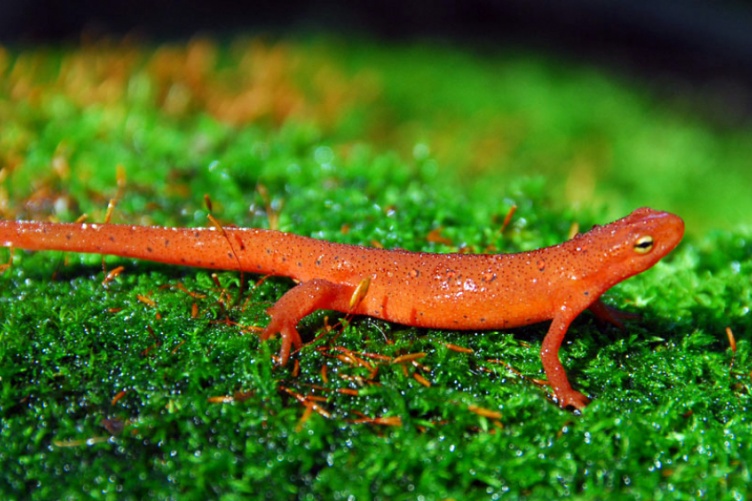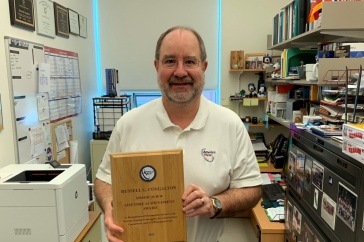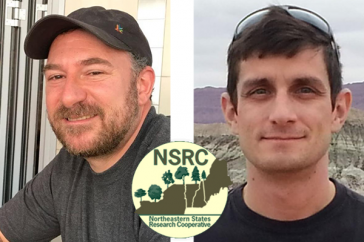
Earth Day may come just once a year, but for scientists with the New Hampshire Agricultural Experiment Station at the University of New Hampshire, every day is Earth Day. Experiment station scientists work year-round conducting leading ecological research that helps sustain the state and region’s natural resources and environment.
Recently scientists found that White Pine Needle Damage, a complex of foliar diseases that is being accelerated by the region’s warmer, wetter springs, is slowing the growth and hampering the health of the region’s eastern white pines. Infected trees experience a yellowing of mature needles in the early spring, followed by a large defoliation event beginning in mid-June.
“This new disease impacts one of New Hampshire’s most widespread and economically important tree species. Eastern white pine composes more than 500,000 acres of New Hampshire forest land. Of the estimated 30 billion board feet of saw timber, 31 percent is eastern white pine,” said experiment station researcher Heidi Asbjornsen, associate professor of natural resources and the environment.
As a result, experiment station researchers are assessing the impacts of the disease on tree health and productivity, and developing silvicultural guidelines for land managers to mitigate the negative impacts of the disease in white pine-dominated forest stands.
Non-native invasive plants also are taking a toll on the eastern white pine and other economically important tree species in New Hampshire and New England. In particular, the shrub glossy buckthorn is known to reduce the regeneration density and growth of trees. When glossy buckthorn is actively managed in forests, experiment station researchers have found the eastern white pine thrives.
Recently, however, experiment station researchers found that planting grass turf in tilled agricultural soil greatly reduced the ability of glossy buckthorn to establish itself in a new area from seed. The new finding provides a promising potential tool for loggers, foresters, and landowners trying to prevent glossy buckthorn from establishing itself in forests.
Scientists also are concerned about our state and regional water resources. They estimate that more than 10 percent of streams in the Merrimack River watershed, which covers areas of New Hampshire and Massachusetts, are impacted by high chloride concentrations as a result of road salt applied during winter. The research is particularly important because salt concentrations can be highest in the summer, raising concerns about harm to freshwater plants, invertebrates, amphibians, and fish.
“Too much salt can harm a variety of freshwater organisms, such as wetland plants, invertebrates, amphibians, and fish. Many of the plants and animals that form the base of the food web that support fish are affected. We need as much good information as we can to make informed decisions about how to trade off winter safety with preservation of our riverine habitats,” said Shan Zuidema, research scientist at the UNH Earth Systems Research Center. He conducted the research with experiment station researcher Wilfred Wollheim, associate professor in the department of natural resources and the environment, and other colleagues from UNH, Plymouth State University, and the U.S. Forest Service.
High levels of salt in rivers and streams are not the only concern. The Northeast and New Hampshire are predicted to experience more frequent dry summers under a shifting climate. Recently researchers found that wildfires alter the chemistry of streams for years, causing significantly lower concentrations of dissolved organic matter, which provides a vital energy source to organisms living in streams and rivers.
“Our study sites in California provide us with an initial predictive framework to understand the potential consequences of wildfire throughout Northern New England. This is, in part, due to similar lithology – granite – between the two study sites, which plays an important role in determining the availability of solutes for export to streams and rivers,” said Adam Wymore, research assistant professor natural resources and the environment.
Wymore conducted the research with experiment station scientist William McDowell, professor of natural resources and the environment and fellow at the American Association for the Advancement of Science. A distinguished professor, McDowell is an international leader in environmental research, with his long-term studies describing the effects of major droughts, rain storms, urbanization and hurricanes on stream chemistry.
Finally, researchers developed guidelines for Midwest farmers experiencing more erratic rainfall and prolonged dry periods that have devastated crops. The portfolio of strategic recommendations, which are eco-friendly and farmer-friendly, are designed to help farmers manage the effects of climate variability and guide future agricultural research, policy, and management specifically for the nation’s breadbasket.
“Climate change is making rainfall more erratic. Less frequent and larger rain events are going to exacerbate agricultural nitrogen losses. Motivated by such weather-related disasters as the Midwest drought in the summer of 2012 and the floods that followed -- a one-two punch that destroyed crops and flushed so much agricultural run-off into streams that nitrate levels surpassed the EPA’s water quality standards -- we focused our efforts on the Midwest, where farmers are vulnerable to changes in rainfall,” said experiment station researcher Stuart Grandy, associate professor of natural resources and the environment.
The team’s recommendations offer hope not only for the Midwest but other regions increasingly impacted by climate variability. “If an agricultural ecosystem’s overall resilience to fluctuating conditions is improved, farmers and the environment will both win. Crops will thrive, water quality will improve, and fewer greenhouse gasses will escape into the atmosphere,” said lead author Tim Bowles, now an assistant professor at the University of California, Berkeley.
This material is based upon work supported by the NH Agricultural Experiment Station, through joint funding of the National Institute of Food and Agriculture, U.S. Department of Agriculture, and the state of New Hampshire.
Founded in 1887, the NH Agricultural Experiment Station at the UNH College of Life Sciences and Agriculture is UNH’s original research center and an elemental component of New Hampshire's land-grant university heritage and mission. We steward federal and state funding, including support from the USDA National Institute of Food and Agriculture, to provide unbiased and objective research concerning diverse aspects of sustainable agriculture and foods, aquaculture, forest management, and related wildlife, natural resources and rural community topics. We maintain the Woodman and Kingman agronomy and horticultural research farms, the Macfarlane Research Greenhouses, the Fairchild Dairy Teaching and Research Center, and the Organic Dairy Research Farm. Additional properties also provide forage, forests and woodlands in direct support to research, teaching, and outreach.
-
Written By:
Lori Wright, '06G | NH Agricultural Experiment Station | lori.wright@unh.edu | 16038621452



















































